The Impact of Nonverbal Communication in Presentations
Have you ever sat through a presentation that was well-designed and interesting, yet you didn’t seem to connect with the speaker? That’s because there is far more that lies beyond the spoken word. While the content of a presentation is certainly important, nonverbal communication can significantly impact the effectiveness of how the message is received. Here we will explore the importance of nonverbal communication and how it can influence presentations.
What is Nonverbal Communication?
Nonverbal communication is also referred to as “the silent language,” as it encompasses all of the ways we convey information without speaking. It is equally as important as the spoken word, but it operates on a subconscious level and can influence the way our message is perceived by an audience. Nonverbal communication is made up of a range of cues including body language, eye contact, facial expressions, appearance, gestures, and even silence.
The Impact of Nonverbal Communication
1. Conveys Emotion and Authenticity
Your facial expressions and tone of voice allow you to express emotions that can provide additional context to spoken words. Nonverbal cues such as a smile or a nod, convey warmth and enthusiasm, while a furrowed brown can signify concern or seriousness. This allows the presenter to make a deeper emotional connection with the audience.
2. Enhance Your Message
Nonverbal communication can also help you clarify your message and emphasize key points, making it easier for the audience to follow along. For example, hand gestures can be used to illustrate important information and engage your audience throughout the presentation. Furthermore, a presenter who speaks clearly and confidently can effectively convey their message and they can vary their tone to create interest and emphasize critical information.
3. Build a Connection
Body language, posture, and facial expressions can also help you establish a strong connection with your audience. Maintaining eye contact, for example, can foster a sense of engagement and develop rapport. Furthermore, a speaker who stands up straight and uses appropriate hand gestures will convey a sense of confidence while also maintaining audience interest.
4. Capture Attention
As stated before, engaging nonverbal cues such as hand gestures, eye contact, and movement can make your presentation more dynamic. This can keep your audience’s attention and prevent them from becoming bored and disengaged.
5. Display Confidence
Finally, nonverbal communication like good posture, intentional movement, and eye contact will exude confidence. When a speaker appears confident, the audience is more likely to trust and respect their message.
Nonverbal communication plays a crucial role in enhancing your message, engaging the audience, and creating a more meaningful and impactful presentation. Presenters who are mindful of their nonverbal communication can greatly improve the effectiveness of their presentations. If you want to improve your presentation skills, enroll today in one of our Presentation Training courses and learn how you can take your speaking skills to the next level!
